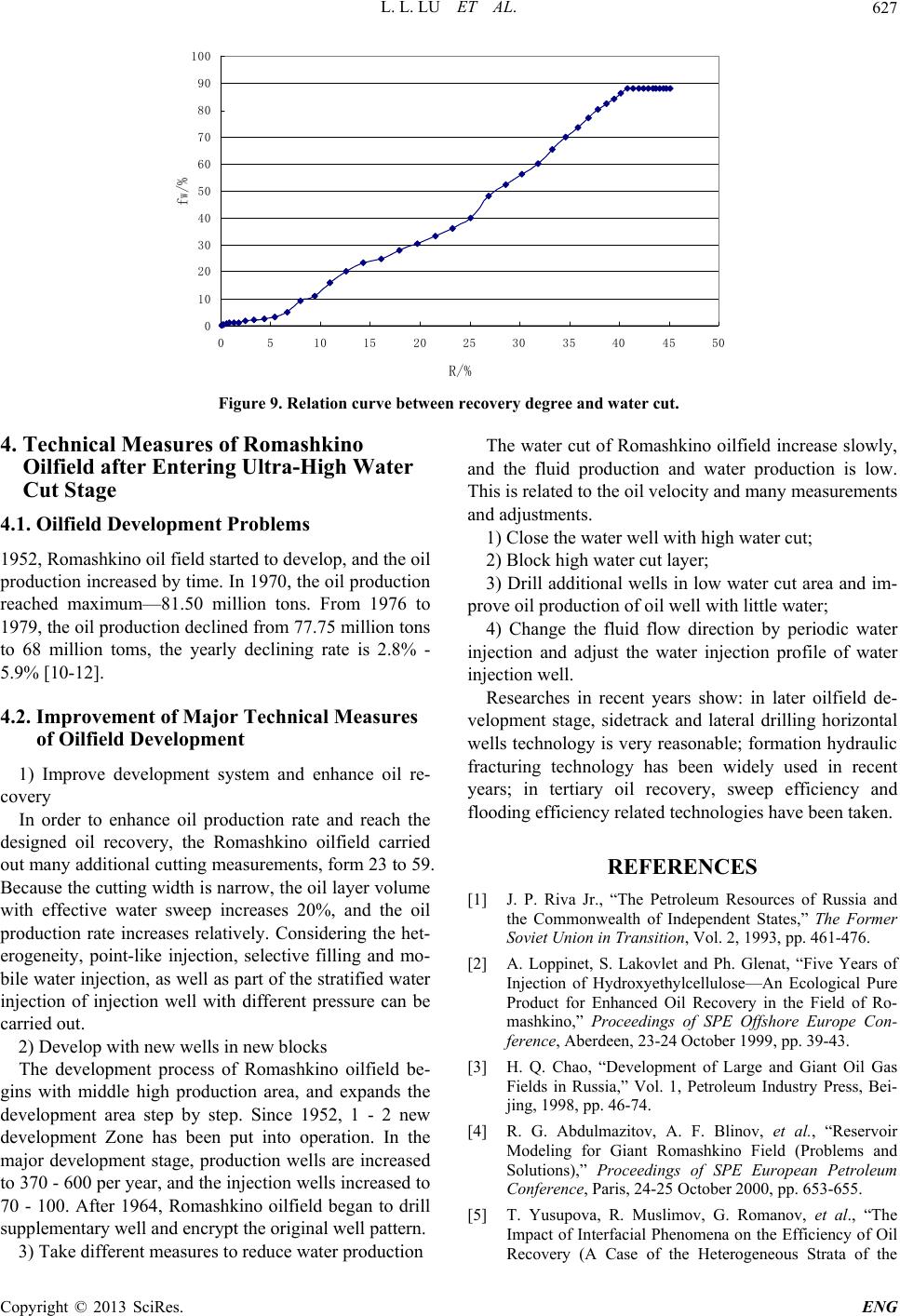
L. L. LU ET AL.
Copyright © 2013 SciRes. ENG
627
0
10
20
30
40
50
60
70
80
90
100
0510 1520 25 3035 4045 50
R/%
f
W
/%
Figure 9. Relation curve between recovery degree and water cut.
4. Technical Measures of Romas h kino
Oilfield after Entering Ultra-
Cut Stage
4.1. Oilfield Development Problems
1952, Romashkino oil field started to develop, and the oil
production increased by time. In 1970, the oil production
reached maximum—81.50 million tons. From 1976 to
1979, the oil production declined from 77.75 million tons
to 68 million toms, the yearly declining rate is 2.8% -
5.9% [10-12].
4.2. Improvement of Major Technical Measures
of Oilfield Development
1) Improve development system and enhance oil re-
covery
In order to enhance oil p
esigned oil recovery, the R
to 59.
wi
idering the het-
g and mo-
ea step by step. Since 1952, 1 - 2 new
to 37 wells increased to
70
entary well and encrypt the original well pattern.
The water cut of Romashkino oilfield increase slowly,
duction and water production is low.
This is related to the oil velocity and many measurements
and adjustments.
1) Close the water well with high water cut;
2) Block high water cut layer;
3) Drill additional wells in low water cut area and im-
prove oil production of oil well with little water;
4) Change the fluid flow direction by periodic water
injection and adjust the water injection profile of water
injection well.
Researches in recent years show: in later oilfield de-
velopment stage, sidetrack and lateral drilling horizontal
wells technology is very reasonable; formation hydraulic
fracturing technology has been widely used in recent
years; in tertiary oil recovery, seep efficiency and
flooding efficiency related technologies have been taken.
iant Oil Gas
Recovery (A Case of the Heterogeneous Strata of the
High Water and the fluid pro
w
roduction rate and reach the
omashkino oilfield carried d
out many additional cutting measurements, form 23
Because the cutting width is narrow, the oil layer volume
th effective water sweep increases 20%, and the oil
production rate increases relatively. Cons
erogeneity, point-like injection, selective fillin
bile water injection, as well as part of the stratified water
injection of injection well with different pressure can be
carried out.
2) Develop with new wells in new blocks
The development process of Romashkino oilfield be-
gins with middle high production area, and expands the
development ar
development Zone has been put into operation. In the
major development stage, production wells are increased
0 - 600 per year, and the injection
- 100. After 1964, Romashkino oilfield began to drill
supplem
3) Take different measures to reduce water production
REFERENCES
[1] J. P. Riva Jr., “The Petroleum Resources of Russia and
the Commonwealth of Independent States,” The Former
Soviet Union in Transition, Vol. 2, 1993, pp. 461-476.
[2] A. Loppinet, S. Lakovlet and Ph. Glenat, “Five Years of
Injection of Hydroxyethylcellulose—An Ecological Pure
Product for Enhanced Oil Recovery in the Field of Ro-
mashkino,” Proceedings of SPE Offshore Europe Con-
ference, Aberdeen, 23-24 October 1999, pp. 39-43.
[3] H. Q. Chao, “Development of Large and G
Fields in Russia,” Vol. 1, Petroleum Industry Press, Bei-
jing, 1998, pp. 46-74.
[4] R. G. Abdulmazitov, A. F. Blinov, et al., “Reservoir
Modeling for Giant Romashkino Field (Problems and
Solutions),” Proceedings of SPE European Petroleum
Conference, Paris, 24-25 October 2000, pp. 653-655.
[5] T. Yusupova, R. Muslimov, G. Romanov, et al., “The
Impact of Interfacial Phenomena on the Efficiency of Oil